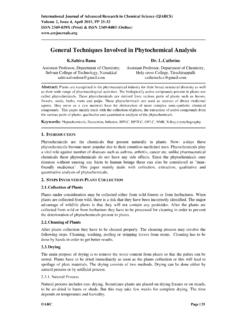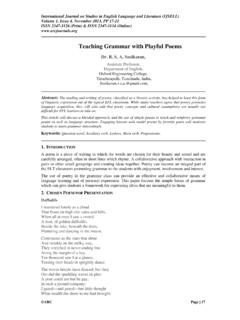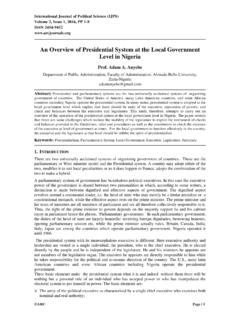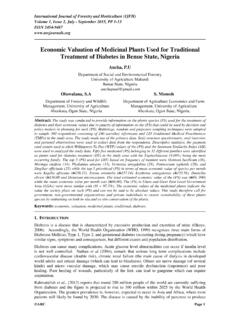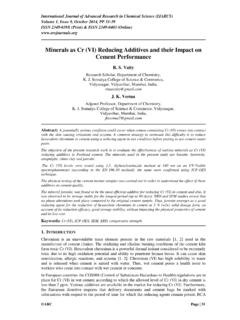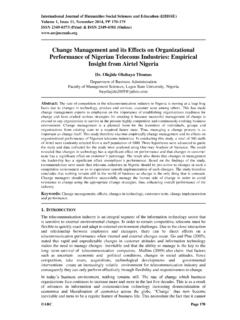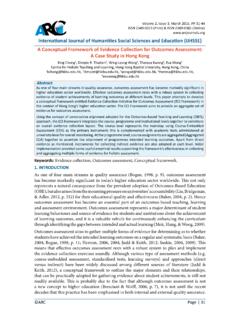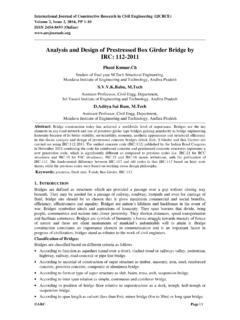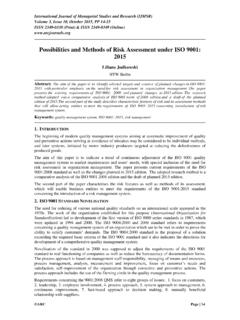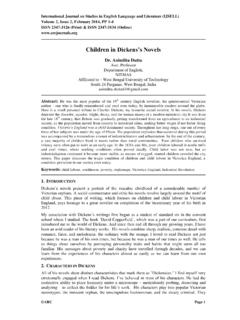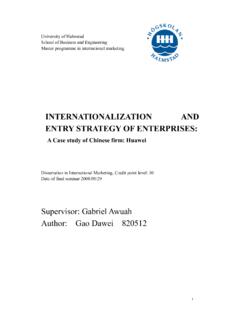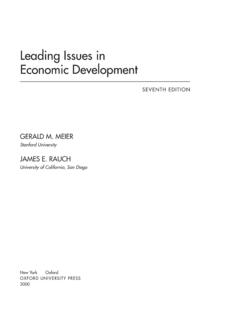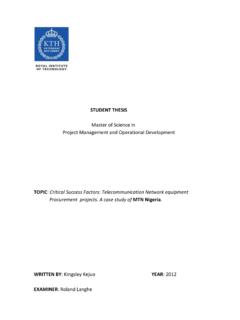Transcription of Food Security in Ethiopia: Review
1 International Journal of Research Studies in Agricultural Sciences (IJRSAS) Volume 5, Issue 1, 2019, PP 1-7 ISSN No. (Online) 2454 6224 DOI: International Journal of Research Studies in Agricultural Sciences (IJRSAS) Page | 1 Food Security in Ethiopia: Review Dagnaygebaw Goshme* College of Agricultural Sciences department of Agricultural Economics, Bulehora University, Ethiopia 1. INTRODUCTION It is widely accepted that food is a basic necessity of life. Its importance at the household level is obvious as food is a basic means of sustenance. Adequate intake of quality food is a key requirement for healthy and productive life which indicates food Security status of a household. A household is food secure if it can reliably gain access to food in sufficient quantity and quality for all household members to enjoy a healthy and active life [1].
2 Food Security and nutrition is at the heart of africa s development agenda with greater commitment to ending hunger, achieving food Security and advancing optimal nutrition for all Africans [2]. Food insecurity, a complex and multi-faceted phenomenon, is currently one of the international community s main priorities, especially in sub-Saharan africa . Food insecurity in this region is most widespread in pockets of extreme poverty, particularly in rural areas; traditional agricultural or general economic interventions alone are unlikely to generate substantial improvements [3]. Majority of poor people in developing country live in rural areas where their livelihood and food Security are dependent on agriculture. Studies indicated that agricultural productivity of rural people in many developing countries is decreasing due to overuse of natural resources, climate change, among others.
3 As a result, it is reported that low level of per capita food production is a common challenge of the countries. Thus achieving food Security requires aggregate availability of physical food supplies, access to food supplies and utilization of food to meet the specific dietary needs of households or individuals in the households [4]. Abstract: Achieving food Security is development agenda for Ethiopia due to the presence of food insecure people in different parts of the country. Over 80 percent of Ethiopian population live in rural areas and are heavily dependent on rain-fed agriculture. Agricultural productivity of rural people is still low due to overuse of natural resources, climate change, and others that reduce per capita food production which is the challenge of the country. The paper Review determinants of food Security , cause of food insecurity and coping strategies practiced in Ethiopia.
4 Annual income, livestock and land holding, livestock feed, fertilizer usage, access to veterinary and extension services, credit access, remittances, access to employment and oxen ownership positively affect food Security while family size, livestock disease, dependency ratio, distance to market, age of the household head negatively affect food Security . Environmental degradation, high population growth, diminishing land holdings, outbreak of plant and livestock disease, pests, chronic shortage of cash income, limited household assets, poor social and infrastructural facility, instability and armed conflicts, pre and post-harvest crop loss and lack of on-farm technological innovations, climate change, drought, flood, frost attack, lack of oxen, poor soil fertility, weak extension services, lack of employment opportunities, high labor wastage, corruption and political instability , lack of appropriate policies and institutions and the like are causes of food insecurity.
5 Sale of more livestock than usual, borrowing of food or cash, reduce number and size of meal, sale firewood and charcoal, seasonal migration, seeking alternative or additional job, rely on less preferred and less expensive food, seeking relief assistance, short term/seasonal migration, seeking alternatives or additional jobs, becoming temporary trade, household splitting, consume wild food, remittance, participating in cash basis project works, diversification of livelihood incomes, Purchasing of grains from market, Renting out land are some of coping strategies practiced in Ethiopia. Keywords: Food Security , Food Insecurity, Determinants, Coping Strategies *Corresponding Author: Dagnaygebaw Goshme, College of Agricultural Sciences department of Agricultural Economics, Bulehora University, Ethiopia Food Security in Ethiopia: Review International Journal of Research Studies in Agricultural Sciences (IJRSAS) Page | 2 Climate change is likely to have adverse effect on the food Security status of people especially those in the developing world and rely on agriculture for their livelihoods.
6 Households who applied changing planting dates as strategy against climate change have high probability of being food secured [5]. Across central Ethiopia, early season dryness worsened in April; creating large rainfall deficits that damaged crop production and pasture development due to this an estimated million people were in Crisis and Emergency [6]. In 2015, Ethiopia faced one of the most severe droughts in half a century due to the effects of El Ni o. It experience between 50 and 90 percent crop loss and the livestock sector has seen extreme mortality and morbidity rates and abnormal migration in search of pasture and water. Many families dependent on agriculture have become indebted and dependent on humanitarian assistance. With inadequate sources of food and income as a result of the drought, vulnerable rural households face widespread hunger and malnutrition.
7 In late 2015, a Government-led multi-agency me her assessment found that million people were food insecure, while 2 million required agricultural input support to resume food production and also in 2016, FAO assist vulnerable families to restore agricultural production, regain their livelihoods and better withstand future crises for million pastoralists, agro pastoralists and smallholder farmers affected by El Ni o [7]. Government of Ethiopia has recently appealed to its international partners for emergency food assistance to feed million people and for special nutritional programmers for more than million, including 400,000 severely malnourished children. In addition, over 8 million vulnerable and food-insecure people receive support under the Productive Safety Net Programmer [8]. The objectives of the Review are; to Review the determinants of food Security , causes of food insecurity and coping strategies practiced in Ethiopia.
8 2. DETERMINANTS OF FOOD Security There are several factors that affect food Security either positively or negatively. Different studies show the determinants of food Security in various parts of Ethiopia. According to [9], determinants of food Security conducted in Gode District, Shebelle Zone of Somali Regional State Ethiopia using binary logic model, family size, annual income, livestock holding, livestock disease, livestock feed, and dependency ratio are the major determinants of food Security , from those family size, livestock disease and dependency ratio are negatively related to food Security , while the remaining are positively related. [10], using binary logic model, show that seven variables were significant determinants of household food insecurity. These were distance to nearest market center, dependency ratio, cultivated land, livestock ownership, oxen ownership, remittance and off-farm income from those distance to nearest market center and dependency ratio were positively related to food insecurity or negatively related to food Security and the remaining are negatively and positively related respectively.
9 According to [11] Age of household head, family size and access to extension services had a negative effect on household food Security status while household income, credit access, oxen ownership and cultivable land size had a positive effect on household food Security . According to studies conducted in Jigjig a District of Ethiopia, use of fertilizer by farming households, total household income, access to veterinary services and access to extension services was found to have a positive and significant impact on household food Security ; whereas, the agro-ecology stratum in which the households farmland was located found to have a negative and statistically significant impact on food Security [12]. [13], using binary logic model, sex and age of the household heads, dependency ratios, household size in adult equivalent, livestock ownership in tropical livestock unit, and fertilizer utilization were determinant factors for food Security status.
10 The study by using binary logic model indicated that household size and age of the household head have positive and significant effect on household food insecurity; whereas, educational status of the household head, asset possession, credit access and access to employment have negative effect [14]. According to [15] conducted in Jigjig a District of Ethiopia, use of fertilizer by farming households, total household income, access to veterinary service and access to extension service was found to have a positive and significant impact on house hold food Security ; whereas the agro ecology stratum Food Security in Ethiopia: Review International Journal of Research Studies in Agricultural Sciences (IJRSAS) Page | 3 in which the households farm land was located found to have a negative and significant effect on household food Security .
